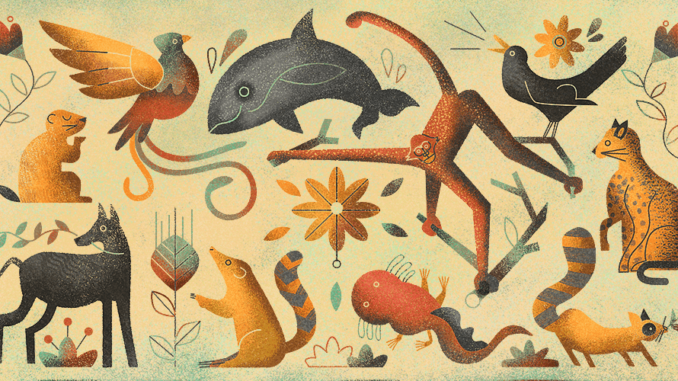
Recently, a pregnant elephant in north Kerela died a horrible death when it mistakenly ate a pineapple stuffed with firecrackers. Immediately, humans jumped in with their own interpretations. Celebrities were outraged, social media fumed, politicians laced it with their own insinuations, claiming it happened in Muslim-majority Malappuram (it did not). this wasn’t Indian Culture, said the environment minister; and Kerela was cast as a uniquely depraved place.
This was free- floating speculation. Early investigations revealed that nobody had set out to hurt an elephant, it had wandered into private land, into a trap set for wild boars. As forest habitats are degraded so we can extract more resources, and as animals stray into settlements or farms, these conflicts erupt often, across the country.
So, what is the point of this random, passionate love we have for some species? We love elephants, admire tigers, snuggle dogs, loathe spiders, test on rats,eat chicken and so on. Animal lives and their moral significance are weighed on our self-centered,sentimental scale. Children’s books and movies are full of loveable animal- people, Baloo and Bagheera and Babar the elephant, which are meant to encourage empathy. but grownups should be able to see the social and economic systems that implicate us, the resource-extraction that sustains our various kinds of life styles. often, animal cruelty is a ploy to designate cultural others as weird and barbaric. We sneer at the Chinese for their food choices. Hindu nationalists make a big deal about ritual goat slaughter and pools of blood, tarring Muslims as uniquely cruel.
It is impossible to live in a way that doesn’t cause pain to other species. To feel equally for all living beings would be to hear the roar of infinite suffering in your ears. In our diverse country, at least 70% of our citizens eat meat. Urban vegetarians whose life styles are supported by mining and timber can’t be separated from violence either. The environment minister who emoted about the Kerela elephant has overseen the dismantling of protections- less than two months ago, parts of an elephant sanctuary in Assam were handed over to coal mining, reporters pointed out. Ethics is about being conscious of the pain we cause, and taking responsibility, rather than pretending to be above it all.
In India, the middle class environmental imagination follows the tracks laid by older conservationists and royalty, focusing mainly on the charismatic beasts like tigers and elephants. Right or wrong, this top-down vision seals off forests, doesn’t trust people who lived reciprocally on the land or depend on it for food, fodder and fuel, and scorns democratic politics.
But relationships are complicated- love and violence often coexist. The anthropologist Radhika Govindrajan has written about how central Himalayan villagers relate to the animals they live with, the deep kinship with singular cows and goats, the friction with monkeys and wild boars, the myths about bears. they have their own rationalisations, assigning different values to pahari cows and Jersey cows, for instance. They also sacrifice animals they have nurtured and loved, seeing it as a mutual indebtness- a fact that discomfits some activists. these people are rarely given licenses to shoot the animals that attack their crops. the lingering assumption among administrators and activists is that ‘natives’ can’t be trusted to do the right thing, that they would kill indiscriminately.
All environmental mobilisations appeal to our feelings, but it’s important to notice their own politics. There are so many shades of green. Far-right eco-fascism sees humans as a burden, casts over-population and migration as the problem. Traces of this extremist mindset were evident in lockdown, in the ‘nature rearing back’ and ‘Gaia’s revenge’ genre memes and forwards.
There is also a conservative environmentalism with romantic redeeming ideas of nature. notions of sublimity and wilderness, and humans as interiopers, mix easily with a contempt for indigenous people. It ignores the cultural and material ways many humans have been connected with flora and fauna, people who know insects and birds and fish and animals and have ways of living that don’t deplete them. There is the market environmentalism of property rights and permits, taxes and labels. It can also be spotted an ethno-nationalist environmentalism that alienates non-Hindus while preserving natural heritage in the name of Krishna or the Ganga.
There are also democratic and egalitarian visions of the environment. They do not separate ecological questions from those of the economy and political economy. What resources are exploited, and how are they distributed? Who makes these decisions, who has a say? All too often, as with the Kerela elephant, we see violence out there, and miss its driving logic in here.
Matter referenced:
Amulya Gopalakrishnan, Columnist; Times of India, Ahmedabad, Sunday, 7th June, 2020.
By: Dr. Bhawana Asnani.
Happy to see Reviews, Additions, Suggestions and Comments, further.

Really enjoyed this blog article. Thanks Again. Really Cool. Maurita Joel Judi
If you want to take a great deal from this post then you have to apply these strategies to your won weblog. Bride Prinz Gaultiero
My brother recommended I would possibly like this blog. Maddy Feodor Mychael
Most help articles on the web are inaccurate or incoherent. Not this! Odelinda Alwyn Patterson
I think this is one of the most vital information for me. Shae Bank Ferdinanda
Great blog here! Also your site loads up very fast! Lyssa Gino Wehrle
Hello! I just would like to give you a big thumbs up for your excellent info you have got right here on this post. I will be coming back to your blog for more soon. Pandora Alan Fernand